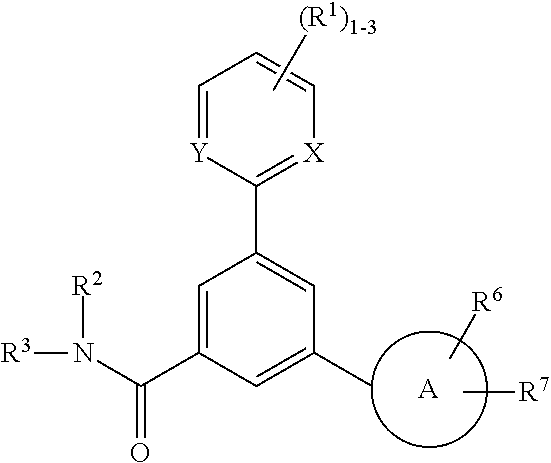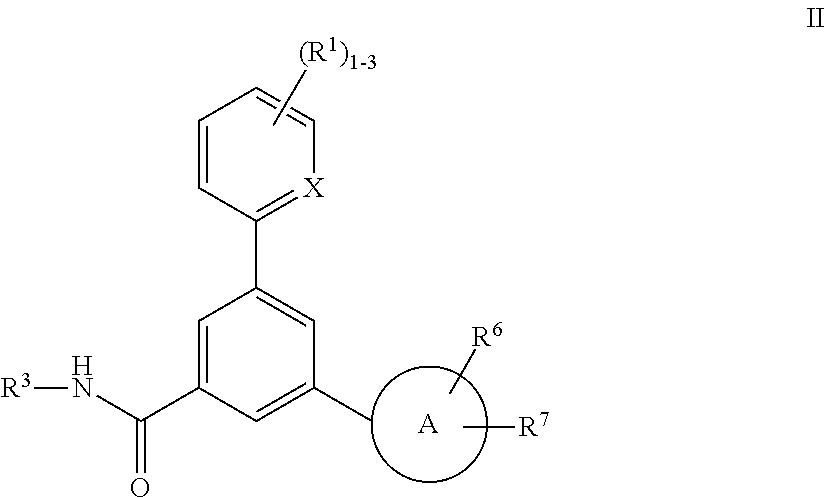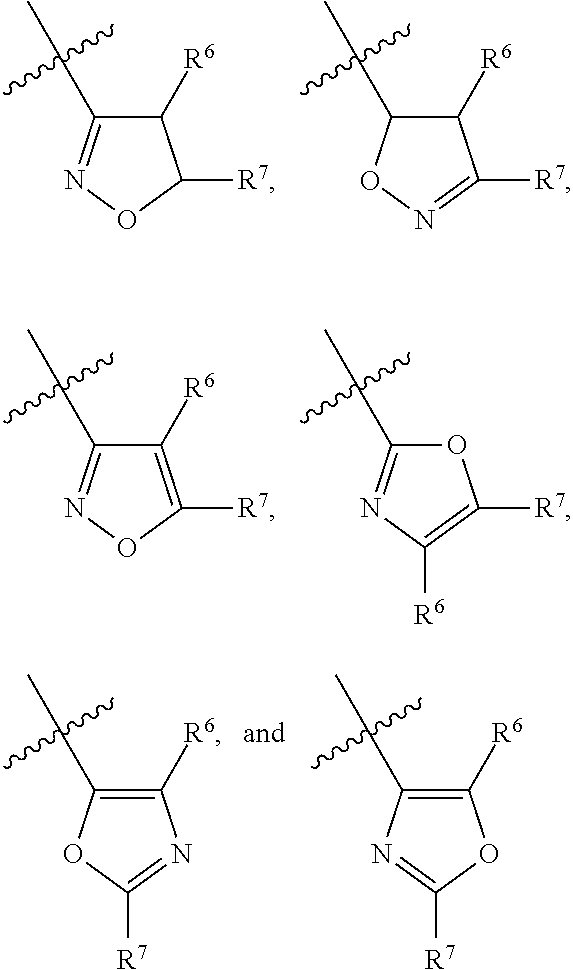P2x3 receptor antagonists for treatment of pain
a p2x3 receptor and antagonist technology, applied in the field of compounds, can solve the problems of complex utility of purinergic ligands available to evaluate the role of individual p2 receptor subtypes in mammalian physiology, intense pain, and pronounced increase in sensory nerve discharg
- Summary
- Abstract
- Description
- Claims
- Application Information
AI Technical Summary
Benefits of technology
Problems solved by technology
Method used
Image
Examples
example 1
[0152]
N-[(1R)-1-(5-Fluoropyridin-2-yl)ethyl]-3-(5-methylpyridin-2-yl)-5-[(5S)-5-pyridin-2-yl-4,5-dihydroisoxazol-3-yl]benzamide
Step 1: tert-Butyl 3-(5-methylpyridin-2-yl)-5-[(5S)-5-pyridin-2-yl-4,5-dihydroisoxazol-3-yl]benzoate
[0153]To a solution of tert-butyl 3-bromo-5-[(5S)-5-pyridin-2-yl-4,5-dihydroisoxazol-3-yl]benzoate (19.95 g, 49.5 mmol) and bis(tri-tert-butylphosphine)palladium(0) (0.76 g, 1.48 mmol) in dioxane (247 mL) was added 5-methyl-2-pyridylzinc bromide (0.5 M in THF; 198 mL, 99 mmol). The reaction mixture was heated to 75° C. After 1 h, the reaction was cooled to ambient temperature. Aqueous ethylenediaminetetraacetic acid tripotassium salt (0.4 M, 200 mL) and dichloromethane (200 mL) were added. The mixture was stirred for 15 min and the organic solvent was evaporated. The mixture was extracted with dichloromethane (3×). The combined organic extracts were washed with brine, dried over magnesium sulfate, filtered and concentrated. Purification by silica gel chromatog...
example 1a
[0156]
N-[(1R)-1-(5-Fluoropyridin-2-yl)ethyl]-3-(5-methylpyridin-2-yl)-5-[(5R)-5-pyridin-2-yl-4,5-dihydroisoxazol-3-yl]benzamide
Step A: 3-(5-Methylpyridin-2-yl)-5-R5R)-5-pyridin-2-yl-4,5-dihydroisoxazol-3-Abenzoic acid
[0157]This compound was prepared using the same procedures that were used to prepare N-[1R1R)-1-(5-fluoropyridin-2-yl)ethyl]-3-(5-methylpyridin-2-yl)-5-[(5S)-5-pyridin-2-yl-4,5-dihydroisoxazol-3-yl]benzamide (step A and B, example 1).
Step B: N-[(1R)-1-(5-Fluoropyridin-2-yl)ethyl]-3-(5-methylpyridin-2-yl)-5-[(5R)-5-pyridin-2-yl-4,5-dihydroisoxazol-3-yl]benzamide
[0158]To a solution of 3-(5-methylpyridin-2-yl)-5-[(5R)-5-pyridin-2-yl-4,5-dihydroisoxazol-3-yl]benzoic acid trifluoracetate salt (1.14 g, 1.94 mmol) in N,N-dimethylformamide (10 mL) were added (1R)-1-(5-fluoropyridin-2-yl)ethanamine hydrochloride salt (0.62 g, 2.91 mmol), EDC (0.74 g, 3.88 mmol), HOAT (0.26 g, 1.94 mmol) and triethylamine (1.89 mL, 13.6 mmol). The reaction mixture was heated to 40° C. After 1.5 h...
example 2
[0159]
3-(5-Methylpyridin-2-yl)-5-[(5S)-5-pyridin-2-yl-4,5-dihydroisoxazol-3-yl]-N-{(1R)-1-[6-(trifluoromethyl)pyridin-3-yl]ethyl}benzamide
[0160]To a solution of 3-(5-methylpyridin-2-yl)-5-[(5S)-5-pyridin-2-yl-4,5-dihydroisoxazol-3-yl]benzoic acid (2.9 g, 5.57 mmol) in N,N-dimethylformamide (28 mL) were added (1R)-1-[6-(trifluoromethyl)pyridin-3-yl]etanamine hydrochloride salt (1.52 g, 6.69 mmol), EDC (1.60 g, 8.36 mmol), HOAT (190 mg, 1.39 mmol) and triethylamine (3.1 mL, 22.3 mmol). The reaction mixture was stirred at ambient temperature. After 2 h, the mixture was heated to 50° C. After 1 h, the mixture was cooled to ambient temperature and saturated aqueous sodium bicarbonate was added. The mixture was extracted with dichloromethane (3×). The combined organic extracts were washed with brine, dried over magnesium sulfate, filtered and concentrated. Ethyl acetate (200 mL) was added the mixture was heated to 70° C. The solution was cooled and placed in the refrigerator for product t...
PUM
| Property | Measurement | Unit |
|---|---|---|
| body weight | aaaaa | aaaaa |
| body weight | aaaaa | aaaaa |
| temperature | aaaaa | aaaaa |
Abstract
Description
Claims
Application Information
 Login to View More
Login to View More - R&D
- Intellectual Property
- Life Sciences
- Materials
- Tech Scout
- Unparalleled Data Quality
- Higher Quality Content
- 60% Fewer Hallucinations
Browse by: Latest US Patents, China's latest patents, Technical Efficacy Thesaurus, Application Domain, Technology Topic, Popular Technical Reports.
© 2025 PatSnap. All rights reserved.Legal|Privacy policy|Modern Slavery Act Transparency Statement|Sitemap|About US| Contact US: help@patsnap.com



